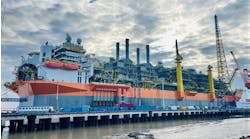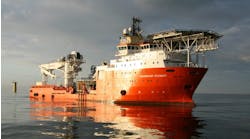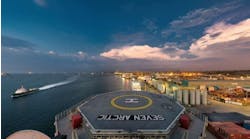Nick Terdre
Contributing Editor
Teekay Shipping Norway has teamed with Det norske oljeselskap to develop its new FlexShuttle shuttle tanker design for an offshore oil loading project.
The Joint Industry Project involves mathematical modeling of the FlexShuttle’s movements and positioning, which will be performed by Marine Cybernetics, assisted by the Ship Maneuvering Simulator Center. The JIP, which has a budget of around NOK12 million ($22 million), is due to be completed by spring 2011. Det norske and Teekay are providing two-thirds of the funds, the remainder supplied by the Research Council of Norway.
Apart from a few units fitted with submerged loading facilities, shuttle tankers currently load oil at sea via a hose over the bow. The FlexShuttle concept reverses this approach, taking oil instead over the stern. A stern loading system similar to the bow loading system has been incorporated into a new shuttle tanker design developed by naval architect Skipskonsulent.
Through incorporating two azimuthing propellers at the stern which are also used for propulsion, the FlexShuttle can improve positioning performance compared with bow loading. This has been demonstrated in model tank tests at the Marintek research center in Trondheim.
The FlexShuttle concept is intended to open the way to direct loading from both fixed and floating installations by providing a solution that is more cost-effective and environmentally friendly than current practice, and at least as safe, according to Stein Rynning, Teekay Shipping Norway’s senior vice president.
At present, direct loading from a production facility to a shuttle tanker only takes place from FPSOs. With fixed installations, all loading has to be done through a separate facility such as a surface or subsea buoy or floating storage unit (FSU) in order to remove any risk of the tanker colliding with the production platform.
With FlexShuttle, however, operators no longer need to include a dedicated loading facility as part of the development, potentially saving both capital and operating costs, Rynning says.
Det norske is interested to see whether the concept could be applied to its planned re-development of the Frøy field in the Norwegian North Sea, and possibly other development projects. The company’s initial solution for Frøy was based around a jackup production platform with oil stored in a seabed tank and offshore loading.
Recently, in an attempt to improve costs, it commissioned a study by Sevan Marine involving a cylindrical FPSO bridge-linked to a wellhead platform. Again, oil would be offshore-loaded after being stored in the FPSO hull.
FlexShuttle is expected to represent a major HSE improvement, especially with regard to offloading from fixed platforms, says Kristian Rothaug, Det norske’s head of the JIP steering committee. He is also clear about the cost benefits. While a storage facility could be part of the fixed installation, the FlexShuttle solution avoids the expense of a pipeline, subsea loading buoy, or floating storage unit. Moreover, facilities such as a submerged loading system impose not only a substantial capital outlay but also high maintenance costs, as they are difficult to inspect.
In contrast, a loading hose installed on the production facility is easy to inspect between each loading operation, which leads to greater reliability and a reduced risk of malfunction and consequent spills to the sea.
The FlexShuttle tanker design represents a significant departure from the conventional tanker layout in which the bridge and accommodation are located at the stern. As the stern has become the business end for loading operations, the bridge and accommodation are located forward.
The design concept also incorporates other state-of-the-art features which promise benefits such as reduced maintenance and environmental impact. The primary fuel is LNG, which means less greenhouse gas emissions than from diesel. FlexShuttle is the first tanker designed to be powered by LNG, but experience has been gained from several LNG-powered platform supply vessels which have been operating in the Norwegian sector in recent years.
Teekay definitely intends to put the FlexShuttle into service, Rynning says. Should Det norske opt for direct loading on Frøy, the first such shuttle tanker could be in service by summer 2013.
In terms of loading capacity, the FlexShuttle can carry around 350,000 bbl, which puts it in the medium range category. It is much smaller than the 850,000-bbl shuttle tankers standard in the Norwegian sector today, and the 500-600,000-bbl vessels used in the UK sector. But its dimensioning suits the many smaller and marginal fields which are being brought onstream, according to Rynning.
As the largest shuttle tanker operator in the Norwegian sector, and in the world, Teekay sees a need for larger-size vessels to service existing fields, and currently has four bow-loading Afromax tankers with 750,000-bbl capacity under construction at the Samsung yard in Korea for service in the Norwegian sector. Two are due for delivery this year and two in 2011.
Offshore loading is used widely in the North Sea and other oil provinces around the world. The FlexShuttle concept is primarily relevant for new developments, but could also be of interest on older fields with fixed installations where loading systems have reached the end of their useful life and have to be taken out of service.




